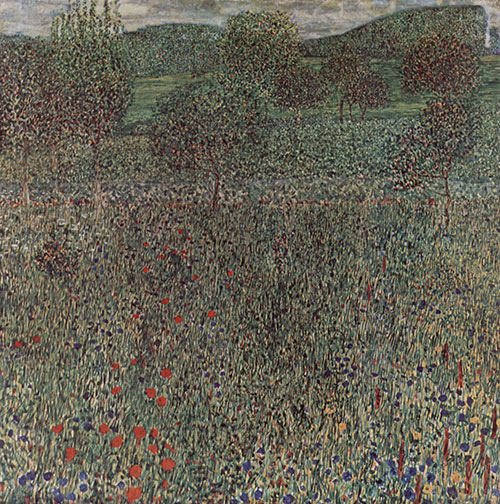The Blooming Field by Gustav Klimt illustrates the artist's brief transition into impressionism, while illustrating traditional realist techniques within his work.
The painting was conceived in 1909, as Klimt explored oil on canvas pieces that accentuated the nature landscape at the time.
During the period, Klimt slightly steered away from his colleagues and his trademark mosaic gold engulfed pieces, to the historic style of landscapes. Klimt had went away for a few summers to Lake Attersee which influenced his style in his landscape pieces.
Klimt went through a period of illustrating the beauty around him, more so than allegorical portraits, metaphysical symbolism and exquisite detail. Historian have stated that Klimt was experiencing a difficult time within his life, and had decided to spend time alone in the nature wildlife that the summer entales.
Blooming Fields illustrates Klimt's emotion as a classic piece that showcases the environment and feeling the artist was engulfed in. The painting illustrates a wide meadow, flowing into the horizon covered in flowers. The painting carries the illusion of depth and a landscape that deepens into the horizon. Through the use of simple vertical brush strokes, Klimt was able to elongate the painting and create a long landscape.
A green field, covered in shades of dark green and glimpse of blue, seizes the beginning of the piece. Flowers cover the meadow in blues and yellows, with prominent red poppies filling the plain. A red vertical flower grows towards the direction of the plain, where it slowly goes away near the centre of the frame.
Multiple tall trees, seeming to resemble apple trees, meet the background of the painting. Klimt will soon go through a minor phase where he will painted three separate paintings of apple trees, that art critics debate are meant to symbolize an emotion within the artist. Behind the large trees, the plain clears towards a cut grass, accompanied by deeper trees within the background the blend in together.
Cool clouds fill the sky at the top of the painting, with glimpse of blue peering through the overshadow. The background of the painting extends into the horizon, covered by trees and hills. The prominent focal point of the painting remains to be the blood red poppies spread across the plain, another signature element Klimt painted within his work, alongside the red apples trees. The artist to accentuate an element within his work commonly uses the colour red.
The overall colour scheme that fills the painting are an array of shades of green, with pops of bright colours to add a contrast. The artist uses small vertical brush strokes throughout the piece to illustrate the texture of the painting, creating a spongy feel to the work. The painting's texture is based on a mosaic pattern mixed with an impressionist technique, that brings the classic pattern into a realist approach.




